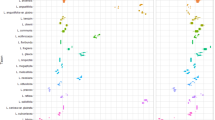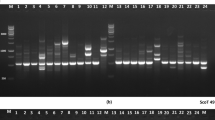Abstract
The genus Coffea, mainly native to Africa and to the Indian Ocean islands (Mascarocoffea), accounts for 124 species. Genome size data are available for 23 African species. The aim of this study was to assess the genome size of 44 Mascarocoffea species and to investigate possible association with species geographic distribution, stomata traits, and species relationships. 2 C values were measured using flow cytometry. A lyophilization procedure for leaves was tested. The 2 C nuclear DNA content of Mascarocoffea species ranged from 0.96 to 1.41 pg. Coffea mauritiana and Coffea humblotiana have the smallest genomes and Coffea millotii has the largest. Mean 2 C DNA for Mascarocoffea and Africa is 1.19 and 1.43 pg, respectively. The overall DNA values corresponded to two partially overlapped normal distributions: one harboring species from east Africa Mascarocoffea, the other harboring species from west/central Africa. Plotted on a geographical map according to the native origin of species, these values showed a gradient in Madagascar and Africa. Genome sizes increased following a north to southeast gradient in Madagascar and an east to west gradient in Africa. None, or only weak correlations were noted between genome size and stomata parameters. Genetically close species could be highly distinctive in their genome size while divergent species could be similarly sized. The non-random geographic distribution and habitat of species, and the absence of correlation between genome size and genetic relationships, suggest that during Coffea genome evolution, both DNA content increase and/or decrease occurred independently in Africa and in the Indian Ocean Islands.







Similar content being viewed by others
Abbreviations
- FL:
-
Fresh leaves
- GCL:
-
Guard cell length
- HD:
-
Hierarchical clustering
- HSD:
-
Honestly significant difference
- LL:
-
Leaf length
- LyL:
-
Lyophilized leaves
- My:
-
Million years
- PI:
-
Propidium Iodide
- SD:
-
Stomata density
References
Anthony F, Clifford MN, Noirot M (1993) Biochemical diversity in the genus Coffea L, chlorogenic acids, caffeine and mozambioside contents. Genet Resour Crop Evol 40:61–70, 1993
Anthony F, Diniz LEC, Combes MC, Lashermes P (2010) Adaptive radiation in Coffea subgenus Coffea L. (Rubiaceae) in Africa and Madagascar. Plant Syst Evol 285:51–64
Barre P, Noirot N, Louarn J, Duperray C, Hamon S (1996) Reliable flow cytometric estimation of nuclear DNA content in coffee trees. Cytometry 24:32–38
Beaulieu JM, Leitch IJ, Knight CA (2007) Genome size evolution in relation to leaf strategy and metabolic rates revisited. Ann Bot 99:495–505
Beaulieu JM, Leitch IJ, Patel S, Pendharkar A, Knight CA (2008) Genome size is a strong predictor of cell size and stomatal density in angiosperms. New Phytol 179:975–986
Bennett MD (1987) Variation in genomic form in plants and its ecological implications. New Phytol 106:177–200
Bennett MD, Leitch IJ (2005) Plant genome size research: a field in focus. Ann Bot 95:1–6
Bouharmont J (1959) Recherches sur les affinités chromosomiques dans le genre Coffea. INEAC (Brussels), Série Sci., 77, 94p
Bouharmont J (1963) Somatic chromosomes of some Coffea species. Euphytica 12:254–257
Bretz F, Hothorn T, Westfall P (2010) Multiple comparisons using R. CRC Boca Raton R.2 .11. 1 http://cran r-project org
Brummitt RK with assistance from Pando F, Hollis S, Brummitt NA et al. (2001) Plant taxonomic database standards No. 2, 2nd edn. World geographical scheme for recording plant distributions, 2nd edn. Pittsburgh, PA: Hunt Institute for Botanical Documentation, Canege Mellon University
Caetano-Anollès G (2005) Evolution in genome size in grass. Crop Sci 45:1809–1816
Campa C, Doulbeau S, Dussert S, Hamon S, Noirot M (2005) Qualitative relationship between caffeine and chlorogenic acid contents among wild Coffea species. Food Chem 93:135–139
Charrier A (1978) La structure génétique des caféiers spontanés de la région malgache (Mascarocoffea): leur relation avec les caféiers d'origine africaine (Eucoffea) PhD Thesis Edn ORSTOM Paris 224pp
Chevalier A (1947) Les caféiers du globe III : Systématique des caféiers et des faux caféiers Edn Paul Lechevalier Paris France 356pp
Coba de la Peña T, Brown SC (2001) Cytometry and fluorimetry. In: Hawes C, Satiat-Jeunemaître B (eds) Plant cell biology: a practical approach. Oxford University Press, Oxford, pp 85–106
Cros J, Combes MC, Chabrillange N, Duperray C, Desangles AM, Hamon S (1995) Nuclear DNA content in the subgenus Coffea (Rubiaceae): inter and intra specific variation in African species. Can J Bot 73:14–20
Cros J, Combes MC, Trouslot P, Anthony F, Hamon S, Charrier A, Lashermes P (1998) Phylogenetic analysis of chloroplast DNA variation in Coffea L. Mol Phylogenet Evol 1:109–117
Davis AP, Govaerts R, Bridson DM, Stoffelen P (2006) An annotated taxonomic conspectus of the genus Coffea (Rubiaceae). Bot J Linn Soc 152:465–512
Davis AP, Tosh J, Ruch N, Fay M (2011) Growing coffee: Psilanthus (Rubiaceae) subsumed on the basis of molecular and morphological data; implications for the size, morphology, distribution and evolutionary history of Coffea. Bot J Linn Soc 167:357–377
Doležel J, Bartoš J (2005) Plant DNA flow cytometry and estimation of nuclear genome size. Ann Bot 95:99–110
Dušková E, Kolar F, Sklenar P et al (2010) Genome size correlates with growth form habitat and phylogeny in the Andean genus Lasiocephalus (Asteraceae). Preslia 82:127–148
Eilam T, Anikster Y, Millet E, Manisterski J, Sagi-Assif O, Feldmann M (2007) Genome size and genome evolution in diploid Triticeae species. Genome 50:1029–1037
Galbraith DW, Harkins KR, Maddox JM, Ayres NM, Sharma DP, Firoozabady E (1983) Rapid flow cytometric analysis of the cell cycle in intact plant tissues. Science 220:1049–1051
Greilhuber J (2005) Intraspecific variation in genome size in angiosperms: identifying its existence. Ann Bot 95:91–98
Hamon P, Siljak-Yakovlev S, Srisuwan S et al (2009) Physical mapping of rDNA and heterochromatin in chromosomes of 16 Coffea species: a revised view of species differentiation. Chromosom Res 19:291–304
Hodgson JG, Sharafi M, Jalili A et al (2010) stomatal vs genome size in angiosperms: the somatic tail wagging the genomic dog? Ann Bot 105:573–584
Jakob SS, Meister A, Blattner RF (2004) The considerable genome size variation of Hordeum species (Poaceae) is linked to phylogeny life form ecology and speciation rates. Mol Biol Evol 21:860–869
Kalendar R, Tanskanen J, Immonen S, Nevo E, Schulman AH (2000) Genome evolution of wild barley (Hordeum spontaneum) by BARE-1 retrotransposon dynamics in response to sharp microclimatic divergence. Proc Natl Acad Sci USA 97:6603–6607
Knight CA, Ackerly DD (2002) Variation in nuclear DNA content across environmental gradients: a quantile regression analysis. Ecol Lett 5:66–76
Knight CA, Beaulieu JM (2008) Genome size scaling through phenotype space. Ann Bot 101:759–766
Lashermes P, Cros J, Combes M-C, Trouslot P, Anthony F, Hamon S, Charrier A (1996) Inheritance and restriction fragment length polymorphism of chloroplast DNA in the genus Coffea L. Theor Appl Genet 93(4):626–632
Lashermes P, Combes MC, Trouslot P, Charrier A (1997) Phylogenetic relationships of coffee-tree species (Coffea L.) as inferred from ITS sequences of nuclear ribosomal DNA. Theor Appl Genet 94:947–955
Lashermes P, Combes MC, Robert J, Trouslot P, D'Hont A, Anthony F, Charrier A (1999) Molecular characterisation and origin of the Coffea arabica L. genome. Mol Gen Genet 261:259–266
Leroy JF (1972a) Prospection des caféiers sauvages de Madagascar: deux espèces remarquables. Adansonia série 2 12: 317-328
Leroy JF (1972b) Prospection des caféiers sauvages de Madagascar: sur deux espèces sympatriques du nord. Adansonia série 2 12: 345-358
Leroy JF (1980) Evolution et taxogenèse chez les caféiers. Hypothèse sur leur origine. Comptes Rendus Hebdomadaires de l’Académie des Sciences de Paris, Série D, 291:593-596
Louarn J (1972) Introduction à l’étude génétique des Mascarocoffea: nouvelles déterminations de leurs nombres chromosomiques. Café Cacao Thé 26: 312-316
Louarn J (1993) Structure génétique des caféiers africains diploïdes basée sur la fertilité des hybrides interspécifiques (Proceedings of the 15th Congress of the International Scientific Association of Coffee Montpellier France) pp 243 -252, ASIC Paris France Publishers
Marie D, Brown SC (1993) A cytometric exercise in plant DNA histograms with 2C values for 70 species. Biol Cell 78:41–51
Maurin O, Davis AP, Chester M, Mvung E, Jaufeerally-Fakim Y, Fay MF (2007) Towards a phylogeny for Coffea (Rubiaceae): identifying well-supported lineages based on nuclear and plastid dna sequences. Ann Bot 100:1565–1583
Morley RJ (2000) Origin and evolution of tropical rain forests. John Wiley and Sons Ltd, Chichester
Noirot M, Barre P, Louarn J, Duperray C, Hamon S (2000) Nucleus–cytosol interactions a source of stoichiometric error in flow cytometric estimation of nuclear DNA content in plants. Ann Bot 86:309–316
Noirot M, Poncet V, Barre P, Hamon P, Hamon S, de Kochko A (2003a) Genome size variation in diploid African Coffea species. Ann Bot 92:709–714
Noirot M, Barre P, Duperray C, Louarn J, Hamon S (2003b) Effects of caffeine and chlorogenic acids on propidium iodie accessibility to DNA: consequences on genome size evaluation in coffee tree. Ann Bot 92:259–264
Noirot M, Barre P, Duperray C, Hamon S, de Kochko A (2005) Investigation on the causes of stoichiometric error in genome size estimation using heat experiments: consequences on data interpretation. Ann Bot 95:111–118
Ohri D, Bhargava A, Chatterjee A (2004) Nuclear DNA amounts of 112 species of tropical hardwoods—new estimates. Plant Biol 6:555–561
Rakotomalala JJ (1992) Diversité biochimique des caféiers: Analyse des acides hydroxycinnamiques, bases puriques et diterpènes glycosides. Particularités des caféiers sauvages de la région malgache (Mascarocoffea Chev.). Thesis, Collection TDM, ORSTOM, Paris
Slovák M, Petr V, Urfus T, Suda J (2009) Complex pattern of genome size variation in a polymorphic member of the Asteraceae. J Biogeogr 36:372–384
Suda J, Trávníček P (2006) Reliable DNA ploidy determination in dehydrated tissues of vascular plants by DAPI flow cytometry—new prospects for plant research. Cytom A 69:273–280
Wells NA (2003) Some hypotheses on the Mesozoic and Cenozoic paleoenvironmental history of Madagascar. In: Goodman S, Banstead J (eds) The natural history of Madagascar. University of Chicago Press, Chicago, pp 16–34
Wendel JF, Cronn RC (2002) Polyploidy and the evolutionary history of cotton. Adv Agron 78:139–186
Yoder AD, Nowak MD (2006) Has vicariance or dispersal been the predominant biogeographic force in Madagascar? Only time will tell. Ann Rev Ecol Evol Syst 37:405–431
Zonneveld BJM, Leitch IJ, Bennett MD (2005) First nuclear DNA amounts in more than 300 angiosperms. Ann Bot 9:229–244
Acknowledgments
Razafinarivo NJ receives a PhD fellowship from IRD and benefits from the RubiComp IRD funds. The Ueshima Coffee Company (UCC) contributes to maintaining the field collection at Kianjavato, Madagascar. We thank FOFIFA authorities and all people who facilitated access and field work at the Kianjavato research station, Madagascar.
Author information
Authors and Affiliations
Corresponding author
Additional information
Communicated by D. Grattapaglia
Rights and permissions
About this article
Cite this article
Razafinarivo, N.J., Rakotomalala, JJ., Brown, S.C. et al. Geographical gradients in the genome size variation of wild coffee trees (Coffea) native to Africa and Indian Ocean islands. Tree Genetics & Genomes 8, 1345–1358 (2012). https://doi.org/10.1007/s11295-012-0520-9
Received:
Revised:
Accepted:
Published:
Issue Date:
DOI: https://doi.org/10.1007/s11295-012-0520-9




